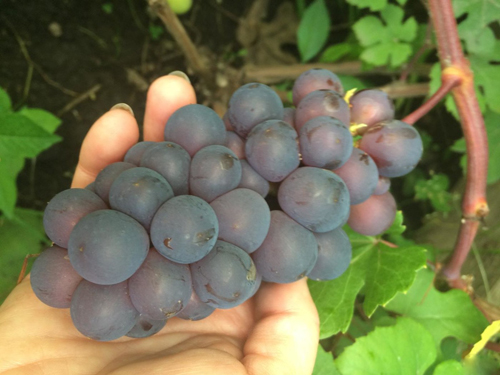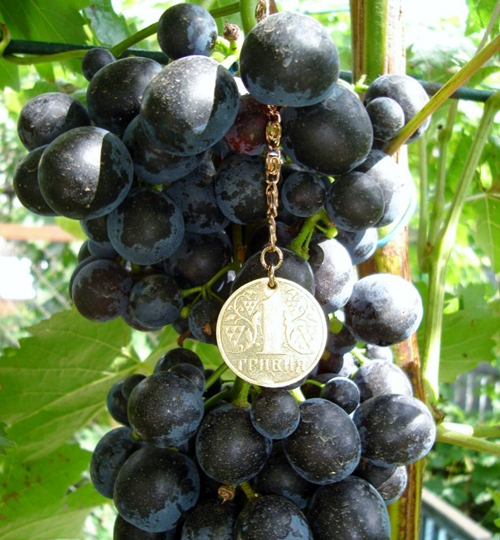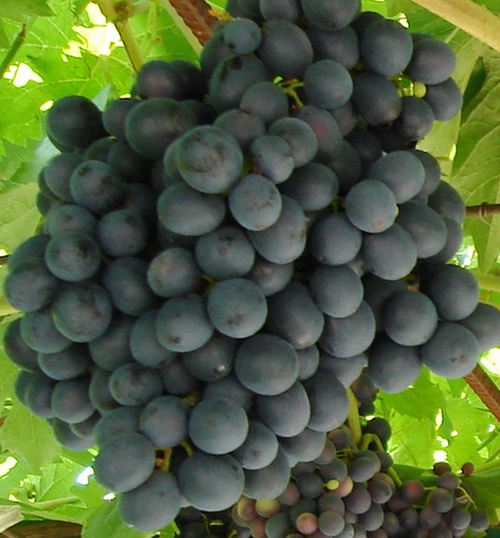Muromets grape variety
Muromets is a fairly old fruitful table grape, mainly for the northern regions of cultivation. Cultivation in areas unconventional for viticulture is facilitated by its early maturity and increased resistance to frost. These factors have attracted many fans, thanks to which the variety has become widespread in the middle zone of the country, in the Urals, and even in Siberia over many decades of its existence.

And it was obtained in 1962 at the Central Genetic Laboratory. IV Michurin, located in the city of Michurinsk, Tambov region. At present, this institution is the All-Russian Research Institute of Genetics and Breeding of Fruit Plants. A married couple of scientists I.M. Fillipenko, L.T. Shtin. To obtain a new form, they crossed the semi-Amur North grapes with a well-known representative of the Central Asian selection called Pobeda. Then, as a result of the selection, a seedling was selected among the hybrid offspring, which later received the name Muromets.
He entered the state variety testing in 1976, 14 years after his birth, and completed it 12 years later - in 1988. As a result, the new variety was recommended for use in three regions at once - the North Caucasus, Nizhnevolzhsky and Ural, which very few varieties included in the State Register of Breeding Achievements can boast of.
Agrobiological characteristics
The bushes are characterized by high vigor. The leaves are usually medium in size, but in some cases they grow large, rounded in shape, three- or five-lobed with an elongated middle lobe, the dissection is medium. The upper side of the grape leaf blade is dark green with light veins, reticulate-wrinkled; dorsal - covered with weak cobweb pubescence. The upper lateral notches are not too deep, open, slit-like or in the form of an inclined angle, the lower ones are shallow, barely outlined, or absent. The petiolate notch can be found in a wide variety of forms: closed, with almost no lumen; open vaulted or open lyre. Petioles are thin, long, reddish-green due to noticeable anthocyanin pigmentation. The teeth along the edge of the leaf are rather large, pointed, with even edges and a not too wide base. The flowers are bisexual, they are sufficiently fertilized with their own pollen, and only in the most unfavorable weather conditions, peas of berries are found during flowering. Annual growth matures satisfactorily - by 60-70% of its length. The ripened parts of the shoots of Muromets acquire a red-brown color.

The bunches of the variety are not of the most outstanding sizes, but they cannot be called small either. The length of the mature brush is up to 20 cm, the width is up to 14 cm, the shape is conical, the structure is moderately dense, less often loose, the average weight is 350-450 grams, and only very rare specimens reach a mass close to a kilogram. The combs are short, herbaceous. The berries are rather large, oval, with a dark purple surface, densely covered with a bluish prune bloom. The mass of 100 grapes ranges from 350-580 grams. The grapes are not damaged or deformed against each other due to their not too dense arrangement in the brush, and, in addition, they are distinguished by a high single-caliber. The pulp of Muromets berries is dense and crunchy in consistency, the taste is harmonious, neutral, there are no memorable distinctive features in the aroma and aftertaste. Sugar accumulation in berries is good - 17-18 g / 100 ml of juice, titratable acidity is low - 4-5 g / l. The skin is thin, torn, easy to chew when eaten. The seeds are small, ranging in number from one to four, but berries without seeds are often found. Taste characteristics are unexpectedly high for the unpretentious northern variety.The average tasting score is 8.5 points.
The grown crop is used for fresh consumption, as well as for home canning. From this variety of grapes, compotes, jams and juices, excellent in taste and rich in color, are obtained. In addition, there is information about the preparation of raisins of acceptable quality from this variety. But our hero does not stand out with great market prospects. This niche has recently been occupied by new hybrid forms characterized by a similar early maturity, and at the same time excellent aesthetic qualities. But if there are farmers who nevertheless pay attention to the old, time-tested Muromets, then in his favor, in addition to the wonderful taste and average presentation by modern standards, it will be possible to attribute good transportability and suitability of the bunches for storage, which are important factors for commercial use. It should be borne in mind that these qualities are characteristic only for grapes harvested very carefully and in dry weather.

The ripening period of the crop for our hero is very early. The growing season in plants, from the time of budding to the onset of consumer ripeness, lasts 110-112 days. Accordingly, his need for heat is very modest. The sum of active temperatures required during this time is 2250-2350 ° C. With such indicators, grapes show the ability to grow in regions with a wide variety of climatic conditions. In particular, the required SAT level is characteristic for the latitude of such cities as Moscow, Kazan and Chelyabinsk, which, in principle, can be considered the northern border of cultivation of this variety in the open field. It has one more important factor to move to non-traditional regions for viticulture - increased frost resistance. And even if its level (-25 ... -26 ° С) does not allow cultivating bushes in a non-covering culture wherever the crop has time to ripen, this moment is still positive, because allows you to significantly reduce the power of winter insulation of the vine, or even go to cover with earth, even in the most frosty conditions.
The yield at Muromets is quite high, despite the average percentage of fruitful shoots and the coefficient of fruiting. The first parameter for him usually fluctuates at the level of 60-65%, and the second - 0.7-0.8. To obtain high yields in this case, a certain specificity of pruning and green operations will be required. But, at the same time, in this variety, overloading of bushes with shoots and crops is also possible. Our hero reacts rather painfully to such shortcomings of the grower, significantly reducing the quality of the grapes, lengthening the ripening period and losing the vigor of shoot growth. In some cases, with a large number of brushes per bush, the berries are pea on them even if the weather was excellent during flowering. Regular overloads threaten the weakening of plants and a decrease in their frost resistance, which can be dangerous not so much for the crop as for the bushes themselves.
Long-term presence of ripe bunches on the vine is quite risky. With heavy rainfall, the variety shows a tendency to cracking berries. This problem manifests itself especially sharply as a result of a sharp change in soil moisture when the dry period changes with torrential rains. And this applies not only to overripe, but only ripening berries. In the event of massive damage to the bunches that have not yet reached the necessary conditions, the only way out will be early harvesting and processing of the unripe crop for compote or jam. Wasps and even flies also cause trouble.The thin skin of the berries is not a special obstacle for them, in connection with which they rush en masse to Muromets, and often, in the absence of protection, cause very serious harm to the crop.
Agrotechnical features
In economic terms, the variety shows itself more on the positive side than on the negative. Like any other grape, it has its own specificity, which is easy to take into account when leaving in order to obtain high results in terms of volume and quality.
It is undemanding to the choice of the planting site, the level of soil fertility, its mechanical composition. Certain problems can arise only in terms of heat supply in the northernmost regions of its cultivation. To avoid them, it is recommended to plant bushes in such conditions in the upper parts of the southern slopes, and in the absence of such an opportunity, at least under protection from cold winds from the south side of houses, outbuildings or dense fences. Areas not suitable for grapes where cold air stagnates, such as beams, valleys, hollows
There is no information about the resistance of the variety to the root phylloxera, and therefore planting in regions infected with this pest is carried out with the help of seedlings grafted onto special rootstocks. In its own-rooted culture, it can be cultivated in areas free from phylloxera, which include all areas of northern viticulture. The recommended feeding area for bushes is 4.5-5 sq. meters.
The need to shelter grape vines for the winter is determined by the minimum values of winter temperatures in the region. With a guaranteed absence of critical frosts for the variety, the plants will grow well on non-covering high-stem formations, while demonstrating all their best qualities. However, if the risk of lowering the thermometer to -25 ° C or more still exists, then there is nothing left to do but form the bushes according to covering squat patterns, and annually insulate their above-ground part for the winter.
To obtain high yields, the plants that have entered fruiting are rather heavily loaded with eyes during spring pruning. Each of them should have 40-45 buds, and the length of the fruit arrows should be 8-10 eyes. The shoots that have developed from them must be carefully thinned out when broken, ruthlessly removing unnecessary, primarily weak and sterile. Ultimately, the load of Muromets with fruitful shoots should be 20-22 per bush, but the bunches on the vine need not be thinned out.
The resistance of the variety to fungal diseases is ambiguous. If grapes demonstrate a certain resistance to mildew, then they are susceptible to mildew and gray rot. This also determines the strategy of its protection, which should include multiple treatments with plant protection products, with an emphasis on the last two diseases. Special protective bags are used against wasps, and on large areas - other, less labor-intensive means.








